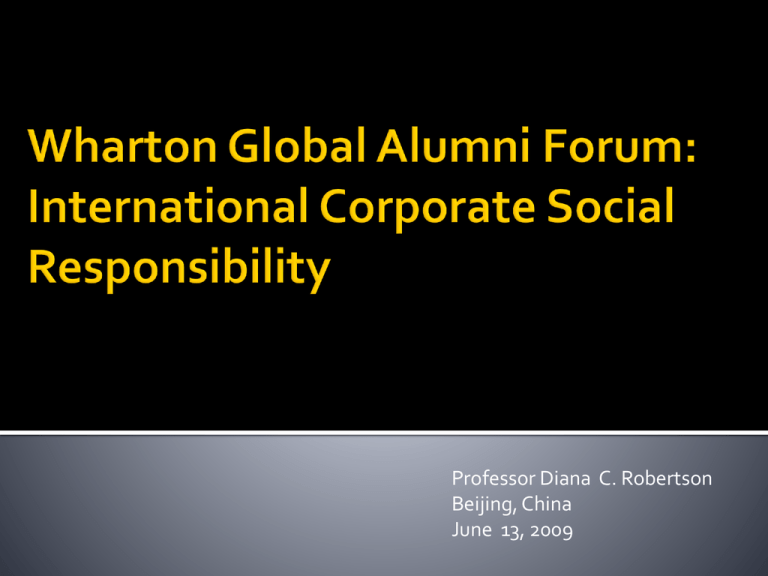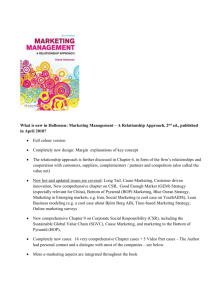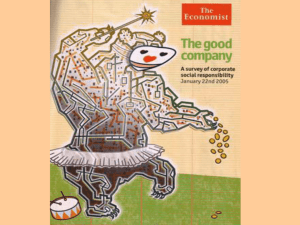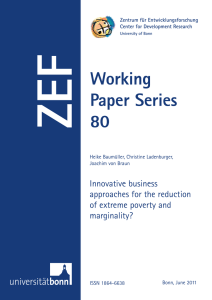WGAF_Beijing

Professor Diana C. Robertson Beijing, China June 13, 2009
2005
2006
2007
2008
What is Corporate Social Responsibility (CSR)?
What’s the case for (and against) CSR?
Debate: Global standards of CSR
What can we learn about best practices of CSR in China?
What’s the future of CSR?
A firm’s efforts to further a social objective, also known as corporate citizenship, triple bottom line, sustainability
Normative and business cases for CSR
Philanthropy Stakeholder model Strategic model –creating value
Mass media Pressure groups Shareholders Employees Local communities Political parties Corporate management Professionals Company Customers Governments Special interest Groups NGOs Suppliers International Organizations Private sector
• Slide Compliments of Klaus Leisinger, Novartis Foundation 8
Page 9
Building reputation
Attracting customers
Attracting and retaining employees
Attracting investors
Milton Friedman’s argument that the “business of business is business”
The firm exists to benefit shareholders
CSR does not contribute to the bottom line
Page 10
“A simple compilation of the findings [from 127 empirical studies over the past 30 years] suggests that there is a positive association, and certainly very little evidence of a negative association, between a company’s social performance and its financial performance.” Margolis, Joshua D., and James P. Walsh, Misery Loves Companies, Administrative Science Quarterly June 2003
Page 11
PRO
Yes, firms should adopt global standards --and here is what they are.
CON
No, firms should not adopt global standards--only country standards—and here is why.
A strategic policy initiative for businesses that are committed to aligning their operations and strategies with ten universally accepted principles rights , labor , environment and in the areas of anti-corruption human
6200 participants, including over 4700 businesses in 120 countries around the world
1147 participants in Asia (20+ countries)
201 participants in China (7 in FT 500)
An overarching framework to measure progress in reducing global poverty Growing Inclusive Markets Initiative:
Launched in 2006
Promote the private sector as a resource for investment and innovation to achieve the MDGs
Field research on the meaning and nature of CSR in three very different economies
Singapore -Enlightened self-interest model Turkey-Philanthropy Ethiopia-Partnerships with NGOs
My conclusion: CSR looks very different and should be tailored to a country’s economic and social needs.
“Golden Bee CSR China Roll” sustainability awards (China WTO Tribune magazine) A total of 60 companies including:
Lenovo
Haier
Pepsi
Eaton
Novartis
Sony
Donated money and resources to help set up 18 “Hope Schools” in rural China.
Funded tuition fees for promising college students
Disaster relief – Sichuan Earthquake
30,000+ food deliveries
Monetary donation to relief effort
Hope through Entrepreneurship Bottom of the Pyramid (BOP) Investments: exploring new products and new business models that bridge the digital divide
The only representative from Asia to be invited to the 7th meeting of the parties to Montreal Protocol
Award-Winning, Environmentally-Friendly Products
China Poverty Reduction
SA 8000 accreditation
Awards:
2006: “2005 Contribution Award for Poverty Reduction” and the title of “Most Respected Enterprises in China” and the award of Top 100 Excellent Enterprises in China’s enterprise social responsibility survey
2007: nominated for the “2006 China Charity Award”
2008: “2007 Special Award for China Poverty Reduction” issued by China Foundation for Poverty Alleviation .
Green Credit Policy
Serving the Community
People's Award for Social Responsibility
2008 Best Corporate Citizen
Ideally integrated with the core business
Compensation and control systems must be aligned with CSR
Should include specific objectives, timetables, and metrics to track progress
Leadership is key
CSR is motivating and contagious
Increased social entrepreneurship
Bottom of the pyramid (BOP) initiatives
Greater focus on microfinance, microinsurance, micro health care insurance
Increased NGO-government corporate partnerships







